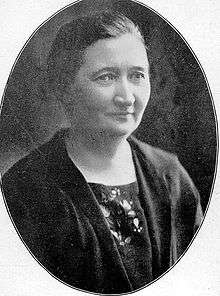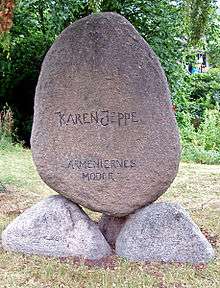Karen Jeppe
| Karen Jeppe | |
|---|---|
 | |
| Born |
1 July 1876 Gylling, Hald Herred, Aarhus County, Denmark |
| Died |
7. July 1935 (aged 59) Aleppo, Syria |
| Occupation | Missionary, Social worker |
Karen Jeppe (1 July 1876 – 7 July 1935) was a Danish missionary and social worker, known for her work aid worker with Ottoman Armenian refugees and survivals of the Armenian Genocide, mainly widows and orphans, from 1903 until her death in Syria in 1935.[1] She was a member of Johannes Lepsius's Deutsche Orient-Mission (German Orient Mission)[2] and assumed responsibility (in 1903[3]) for the Armenian children in the Millet Khan German Refugee Orphanage after the 1895 Urfa massacres.[4]
Work and activities
Before World War I
In 1902, Jeppe first heard about the persecutions of the Armenians in the Ottoman Empire, from her school headmaster H. C. Frederiksen (called also Friser) who represented an article written by Aage Meyer Benedictsen (1866–1927),[5] a Danish-Jewish-Icelandic linguist, writer, philologist and a secular antiimperialist intellectual.[6] Shortly after, she attended Benedictsen's lecture in Copenhagen, where he ended his talk by a cry for help to the Armenian people, passed on from an old Armenian. Benedictsen himself, was one of the first Danish cosmopolitans who was interested in the persecution of the Ottoman Armenians, and during one of his travels to Persia he visited the German Orient Mission in Urfa, which had started a school-orphanage, under the direct supervision of the German clergyman Johannes Lepsius. When Benedictsen returned to Denmark in 1902, he took the initiative to found the secular organization of the Danish Friends of Armenians ("Danske Armeniervenner" DA).[5]
Deeply moved by Benedictsen's lecture, Jeppe was informed by him that Dr. Lepsius was just looking for a woman teacher for the school in Urfa. On 1 October 1903, she left home for a long journey across Europe and Asia Minor to arrive in Urfa (nowadays Şanlıurfa in Turkey), where she was welcomed by hundreds of Armenians, gathered to meet the newly arrived European lady.[5] Within a year, she learnt Armenian, Arabic and Turkish, after which she started working at the school introducing new methods of teaching.
In 1909, after the Adana massacres, Jeppe continued her work in providing the daily bread for the Armenians, buying a piece of land in the mountains, where she planted vineyards, building up good relations with Kurds and Arabs. She was assisted by Misak Melkonian, a young Armenian orphan whom she had adopted.[7] During that period, Jeppe had also adopted Lucia, an orphan survival of the Genocide.[5]
During World War I
After the outbreak of World War I, massacres and mass killings of Armenians were conducted by the Young Turks. Jeppe tried to organize rescue efforts and help the Armenian refugees driven through Urfa, on their way to the camps of death in the Syrian desert of Deir ez-Zor, with providing food and water and hiding many of them under the floor of her house.[3][8][9] She never left Urfa during the war and helped many Armenians to escape by disguising them as Kurds and Arabs.[5][10] After World War I she was forced, due to ill-health, to return to Denmark in 1918, where she campaigned on behalf of Armenians.
Jeppe in Aleppo

After spending three years in Denmark, Jeppe decided to return to Syria. Upon her arrival at Aleppo in 1921, she found employment for Armenian widows by establishing orphanages, schools, medical clinics and workrooms, then worked to rescue two thousand Armenian women and children scattered in the area, as Aleppo director of the Commission for the Protection of Women and Children in the Near East, under the auspices of the League of Nations.[3][11][12] However, the situation was deeply worsened in 1922, as new waves of Armenian refugees arrived in Aleppo escaping from the massacres in Cilicia, as the French troops -despite promises to the contrary- had evacuated Cilicia in 1921, leaving thousands of Armenians to be killed or expelled by Turkish nationalists.[5][13]
In 1924, after negotiations with a rich Bedouin sheik; Hadjim Pasha, Jeppe rented parts of his lands to the west of Aleppo in the valley of Euphrates, at a fair price.[14] In 1925, she was joined by two new assistants from Denmark; Jenny Jensen and Karen Bjerre who helped her to concentrate her efforts on this project. On the other hand, the French rulers in Syria had offered to create an agricultural colony for the Armenian refugees, but nobody joined in. However, the Armenians had lost confidence in the French rulers, after their withdrawal from Cilicia, which brought a fatal consequence to many of their compatriots.[5][15]
Hadjim Pasha became a good friend of Karen Jeppe, helping her with practical things and maintaining the security of the new Armenian settlers through his status and the effect that he had in the region.[16]
Life in the 1930s and death


Karen Jeppe made all possible efforts to create good relations between Bedouins and Armenian peasants, through which, she succeeded to found six Armenian farming colonies in the region of Raqqa like Tel Armen, Tel Samen, Charp Bedros, Tineh, etc.[17]
Jeppe visited Denmark for the last time in autumn 1933. Upon her return to Syria, she had been affected by malaria. Having partly recovered, she continued to direct her efforts towards the development of the newly created Armenian communities. In the summer of 1935, she suffered a more serious attack of malaria during her stay at her white house in the agricultural colony. She was taken to the hospital in Aleppo, where she died on 7 July 1935, at the age of 59.[5] She was buried in the Armenian cemetery of Aleppo.[18]
Karen Jeppe was described as the "Danish Mother of Armenians" by Yerevan International Film Festival known as Golden Apricot International Film Festival.[19]
The first-established Armenian higher educational college in Aleppo (opened in 1946) is named after Karen Jeppe.[20]
In 1927, Denmark bestowed the Medal of Merit in Gold (Danish: Fortjenstmedaljen i Guld) upon Jeppe.[21]
See also
Notes
- ↑ Nordic Perspectives on Colonialism: Conference arranged by Netværk for Global Kulturhistorie (Network for Global Cultural History), University of Aarhus, in Höör, Sweden 11–12 January 2007.
- ↑ http://etd.lib.fsu.edu/theses/available/etd-07062006-120724/unrestricted/JK_Dissertation.pdf Danes, Orientalism and the Modern Middle East: Perspectives from the Nordic Periphery, p. 125, unpublished Ph. D. dissertation, Florida State University 2006 by Jonas Kauffeldt
- 1 2 3 Ephraim, K. Jernazian (1 January 1990). Judgment Unto Truth (Zoryan Institute Survivors' Memoirs). Alice Haig (trans.). Transaction Publishers. pp. 65–67. ISBN 0-88738-823-X.
- ↑ Künzler, Jakob (2007). In the Land of Blood and Tears. Arlington: Armenian Cultural Foundation. pp. xxiv. ISBN 0-9674621-8-5.
- 1 2 3 4 5 6 7 8 http://www.fredsakademiet.dk/library/ukjeppe.htm The Danish Peace Academy: Karen Jeppe, Denmark's First Peace Philosopher by Eva Lous 2003
- ↑ Before the Armenian Genocide: Danish Missionary and Rescue Operations in the Ottoman Empire, 1900-1914 by Matthias Bjørnlund, Haigazian Armenological Review, Vol. 26, 2006, pp. 141-156.
- ↑ Armeniervennen, Vol. 6, Nos. 9-10, September–October 1926, p. 40
- ↑ Autobiography and Recollections by Bedros Der Bedrossian, Philadelphia 2005
- ↑ Armenien und die Schweiz – Geschichte der Schweizerischen Armenierhilfe by Karl Meyer, Bern: Blaukreuz-Verlag 1974, pp. 94, 110
- ↑ Pigen fra Danmark by Ingeborg Marie Sick, Copenhagen: Gyldendal 1928, pp. 89-132.
- ↑ Baron, Nick (2004). Homelands: War, Population and Statehood in Eastern Europe and Russia, 1918-1924. City: Anthem Press. p. 197. ISBN 1-84331-121-6.
- ↑ Watenpaugh, Keith (2006). Being Modern in the Middle East. Princeton: Princeton University Press. p. 284. ISBN 0-691-12169-9.
- ↑ Testimonies on the French defeat in and evacuation of Cilicia provided by Armenian survivors Digin Gulinian and Sahag Boghosian in KMA Archives, Arkivnr. 10.360, Pk. Nr. 15, Armenier-Missionen, Diverse Skildringer vedr. Arminierne [sic] 1906-1927.
- ↑ Karen Jeppe archive, Letter from Jeppe to Nyholm, 22 November 1924.
- ↑ Kolonierne i Syrien, Armeniervennen by Henni Forchhammer, Vol. 4, Nos. 11-12, November–December 1924, pp. 49-50.
- ↑ Kolonierne i Syrien, Armeniervennen by Henni Forchhammer Vol. 6, Nos. 7-8, July–August 1926, p. 31.
- ↑ , Den Hvide Slavehandel. Bekæmpelse af Handel med Kvinder 1900-1950 by Hanne Rimmen Nielsen, Kvinder, Køn & Forskning, Vol. 19, No. 3, 2001, pp. 10-24.
- ↑ http://www.aibidji.dk/version_ENGELSK_AIBIDJI/historie/karen_jeppe/karen_jeppe.htm History:Karen Jeppe
- ↑ Yerevan International Film Festival
- ↑ http://www.karenjeppegemaran.com/ Karen Jeppe Armenian College, Aleppo
- ↑ Karen Jeppe – den glemte heltinde(in Danish)
External links
| Wikimedia Commons has media related to Karen Jeppe. |
- Karen Jeppe Armenian College of Aleppo
- Jeppe on Gardens of the Righteous Worldwide Committee - Gariwo
- Jeppe on the Danish Peace Academy Website